Overview
The article highlights the significant advantages of multi-channel pipettes in pharmaceutical laboratories, underscoring their critical role in enhancing efficiency, accuracy, cost-effectiveness, and user comfort.
These advanced instruments facilitate streamlined sample handling by enabling simultaneous processing, which not only reduces reagent consumption but also minimizes human error.
Collectively, these benefits contribute to heightened operational productivity and ensure compliance with regulatory standards in drug development.
The implementation of multi-channel pipettes is essential for laboratories striving to optimize their workflows and maintain the highest quality in their research and development efforts.
Introduction
Multi-channel pipettes have revolutionized the landscape of pharmaceutical laboratories, offering a compelling combination of precision, efficiency, and ergonomic design that significantly enhances daily operations. These sophisticated instruments not only streamline sample handling and mitigate the risk of human error but also substantially reduce reagent waste and labor costs.
As laboratories increasingly depend on these tools, critical questions emerge regarding their genuine impact on workflow and research outcomes—are they merely a convenience, or do they fundamentally enhance the quality and reliability of pharmaceutical research?
This article explores the numerous advantages of multi-channel pipettes, examining how they can elevate laboratory practices and meet the rigorous demands of drug development.
JM Science Multi-Channel Pipettes: Precision and Reliability for Pharmaceutical Labs
JM Science offers a comprehensive range of multi channel pipettes that are specifically designed for pharmaceutical laboratories. These laboratory instruments are engineered for precision and reliability, ensuring that every sample is processed with the highest accuracy. By integrating advanced technology, multi channel pipettes significantly minimize human error, making them an indispensable asset for any laboratory focused on drug development and research. Their ergonomic design facilitates extended use without sacrificing comfort, a crucial factor in high-throughput environments. Furthermore, these instruments are integral to the titration process, particularly when utilized in conjunction with Karl Fischer titrators, thereby enhancing the efficiency and accuracy of drug testing procedures in accordance with the Japanese Pharmacopoeia.
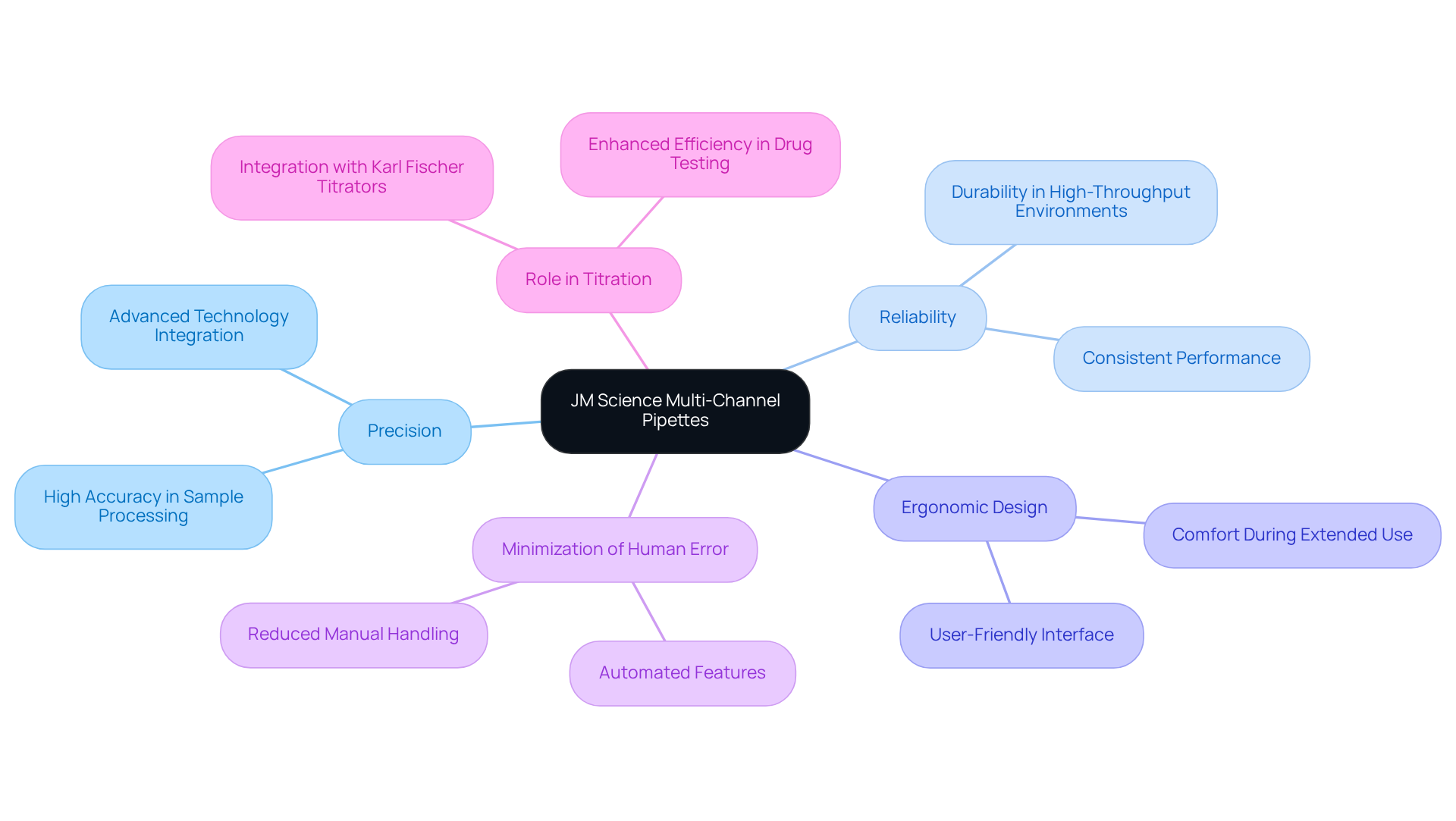
Increased Efficiency: Streamlining Sample Handling with Multi-Channel Pipettes
Multi-channel pipettes enable researchers to manage multiple samples simultaneously, significantly decreasing the time needed for sample preparation and assay setup. In high-throughput environments, where efficiency is critical, these instruments truly shine. For instance, multi-channel pipettes can fill a 96-well plate in a fraction of the time required for single-channel liquid handling, thereby streamlining the workflow considerably. This capability not only boosts productivity but also reduces the likelihood of errors associated with repetitive single-channel transfers, ultimately resulting in more dependable outcomes.
Researchers have noted that employing multi-channel pipettes can cut sample preparation time by up to 50%, allowing teams to focus on vital analyses rather than tedious liquid handling tasks. As Kelly Sullivan, PhD, Director of Lab Operations, asserts, 'Efficiency in lab operations is paramount, and instruments such as multi-channel pipettes are essential for achieving that goal.'
The integration of these tools into experimental protocols exemplifies a commitment to enhancing operational efficiency and fostering high-quality research results. Furthermore, the growing use of microtiter plates in the drug discovery sector highlights the increasing importance of these instruments in modern research facilities. A case study on 'Multi-Channel Pipettes Efficiency' demonstrates how these devices tackle the challenges faced by researchers reliant on single-channel instruments, ultimately improving experimental reproducibility and alleviating physical strain on researchers.
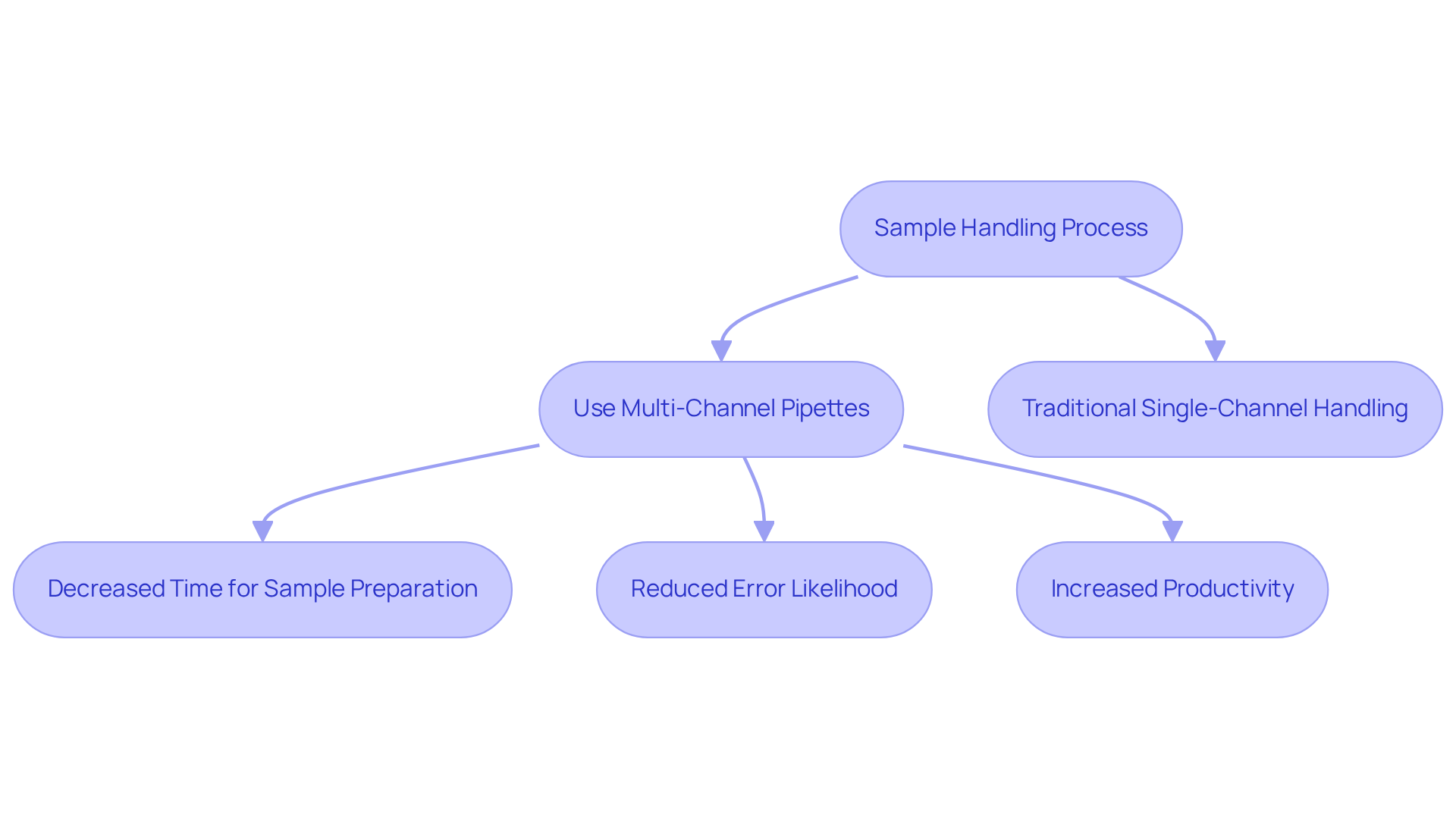
Cost-Effectiveness: Reducing Reagents and Time with Multi-Channel Pipettes
Multi-channel pipettes represent a transformative investment for pharmaceutical facilities, providing substantial cost reductions through efficient liquid management. By facilitating the simultaneous dispensing of multiple samples, multi-channel pipettes significantly lower reagent consumption, with studies demonstrating an average reduction of up to 30% compared to traditional single-channel pipettes. This reduction not only minimizes waste but also fosters more sustainable practices within the laboratory environment.
As Microlit asserts, "At Microlit, we understand the critical role precise liquid handling plays in the success of modern laboratories." The financial advantages extend beyond mere reagent savings. The efficient workflow enabled by various channel dispensers leads to considerable time savings, which can significantly decrease labor expenses. In high-throughput settings, for instance, the utilization of these tools can enhance productivity by allowing researchers to focus on essential tasks rather than repetitive liquid handling. Financial analysts have noted that the return on investment (ROI) for adopting versatile liquid handling devices can be realized within months, particularly in environments where reagent costs and labor efficiency are paramount.
Moreover, the application of diverse liquid dispensers has been linked to improved experimental reproducibility, thereby increasing the reliability of outcomes. This aspect is especially critical in pharmaceutical research, where precision is indispensable. By reducing reagent waste and optimizing labor resources, multi-channel pipettes not only bolster operational efficiency but also contribute to the overarching goal of advancing pharmaceutical development. Additionally, the use of these tools mitigates the risk of Repetitive Strain Injuries (RSIs), addressing concerns related to worker health and productivity in research environments.
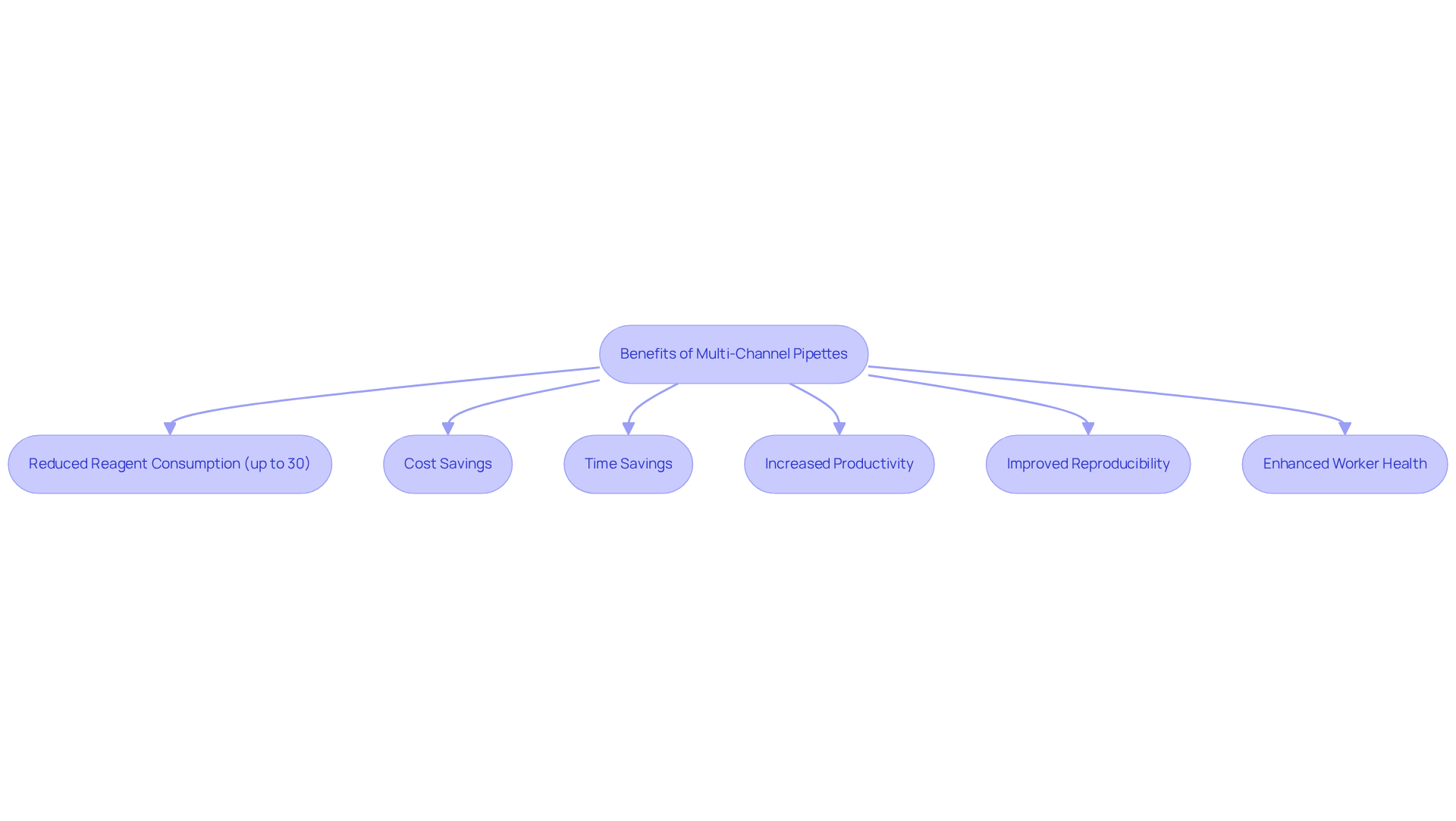
Versatility: Adapting Multi-Channel Pipettes for Diverse Pharmaceutical Applications
Multi-channel pipettes serve as indispensable tools in pharmaceutical laboratories, demonstrating exceptional adaptability across a wide range of applications, including ELISA assays, PCR setups, and cell culture work. Their design incorporates adjustable volume settings and interchangeable tips, rendering them ideal for both high-throughput screening and precise liquid handling. This versatility is paramount, enabling researchers to efficiently manage diverse tasks while ensuring accuracy and reproducibility in their results.
For instance, in ELISA tests, multi-channel pipettes facilitate concurrent sample handling, significantly reducing time and minimizing the likelihood of human error. Likewise, in PCR setups, using multi-channel pipettes ensures consistent volume dispensing across multiple samples, which is crucial for achieving reliable amplification results.
Statistics reveal that the versatility of multi-channel dispensers enhances laboratory workflows, with the pharmaceutical sector commanding the largest market share of 38% in 2023, underscoring their significance in this field. Researchers, including Sanket Gokhale, have noted that multi-channel pipettes can be seamlessly integrated into various scientific tasks, emphasizing their role as essential tools in contemporary pharmaceutical research.
Furthermore, the ergonomic design of many automatic multichannel liquid handling devices promotes comfortable use during prolonged periods, further enhancing their desirability in laboratory environments. The ongoing trend of automation and digitization in the liquid handling instrument market is also propelling the demand for advanced features, solidifying the necessity of these devices in modern research settings.
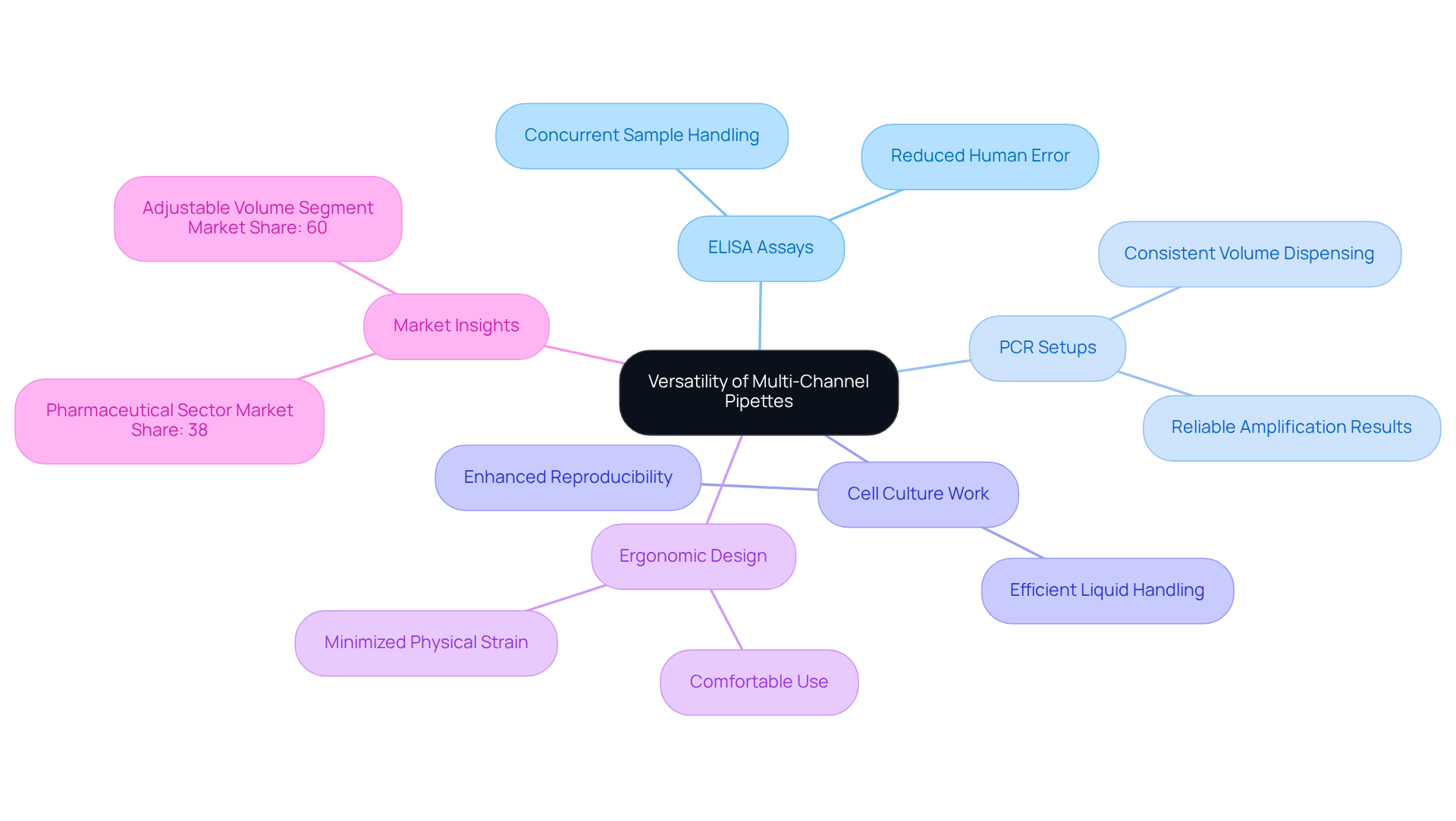
Enhanced Accuracy: Achieving Reliable Results with Multi-Channel Pipettes
Multi-channel pipettes are designed to deliver precise volumes consistently across all channels, which is a critical factor for achieving reliable results in pharmaceutical research. By minimizing the manual steps involved in liquid handling, these instruments significantly reduce the risk of human error. This ensures that experiments yield reproducible and accurate data, which is paramount for maintaining compliance with regulatory standards in drug development. The reliability of these dispensers not only enhances experimental integrity but also reinforces the importance of utilizing high-quality scientific instruments in laboratory environments.
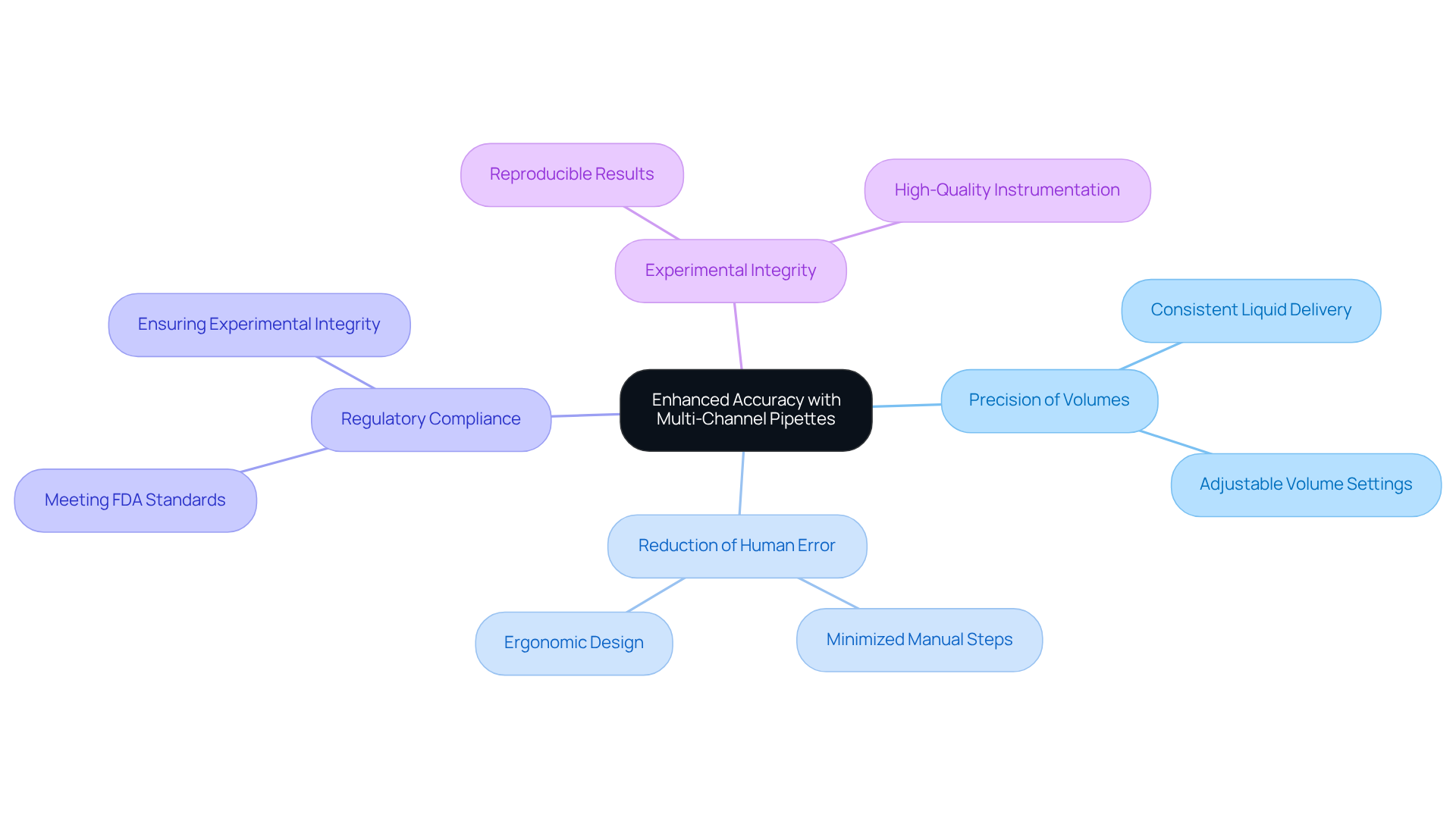
Ergonomic Design: Improving User Comfort with Multi-Channel Pipettes
The ergonomic design of multi channel pipettes is crucial for enhancing user comfort, significantly reducing the risk of repetitive strain injuries (RSI) during prolonged use. Features such as a lightweight structure, padded handles, and minimal application forces simplify management of these instruments. This enables researchers to maintain concentration and efficiency throughout their workday. Such attention to ergonomics is particularly essential in high-throughput environments, where the use of multi channel pipettes makes pipetting tasks both frequent and time-consuming. By prioritizing ergonomic design, laboratories can foster a more productive and healthier workspace.
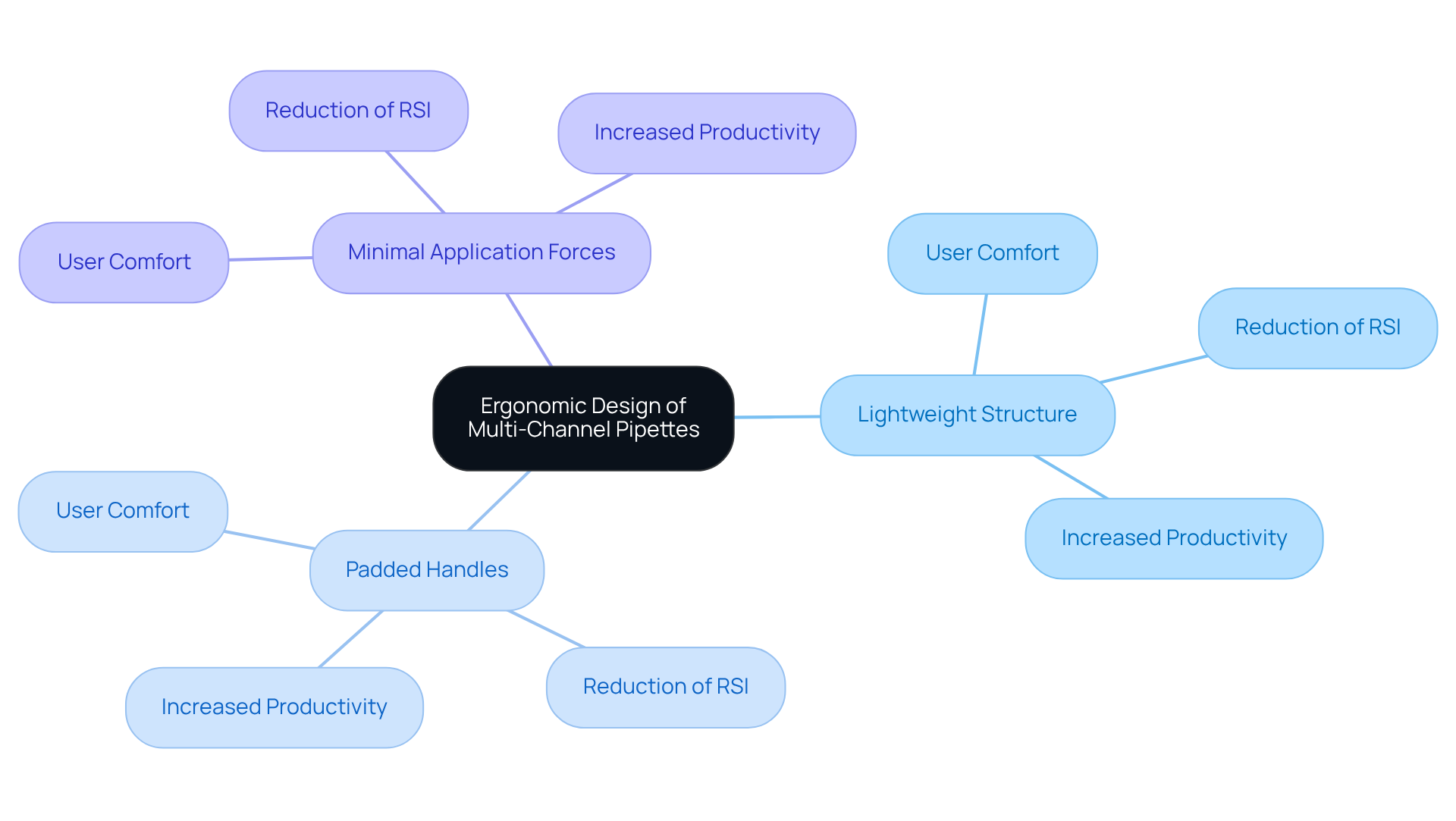
User-Friendly Operation: Simplifying Training with Multi-Channel Pipettes
Multi-channel pipettes signify a crucial improvement in laboratory efficiency, equipped with user-friendly features that greatly simplify the training process for new staff. Their intuitive design, combined with clear labeling, enables users to quickly comprehend their operation, effectively reducing the learning curve associated with liquid handling tasks. This ease of use not only enhances productivity but also fosters a safer working environment by minimizing the risk of errors during pipetting. Research demonstrates that implementing straightforward training programs can elevate pipetting accuracy, underscoring the correlation between effective training with intuitive tools and improved laboratory outcomes.
Moreover, the Mean Time Before Failure (MTBF) for these devices is approximately 18.8 months, emphasizing their reliability in critical settings. The prevalence of liquid delivery mistakes underscores the necessity of dependable instruments; studies reveal that up to 30 percent of dispensing tools may not function within expected tolerances, making the selection of user-friendly devices essential. A case study on the efficiency of multi-channel pipettes illustrates that these instruments not only enhance productivity in research environments but also reduce physical strain on scientists.
By adopting multi-channel pipettes, research facilities can ensure that new personnel are equipped with the optimal instruments for success, ultimately cultivating a more efficient and compliant research environment. The strategic implementation of these tools can lead to significant improvements in operational effectiveness, reinforcing the importance of investing in high-quality scientific instruments.
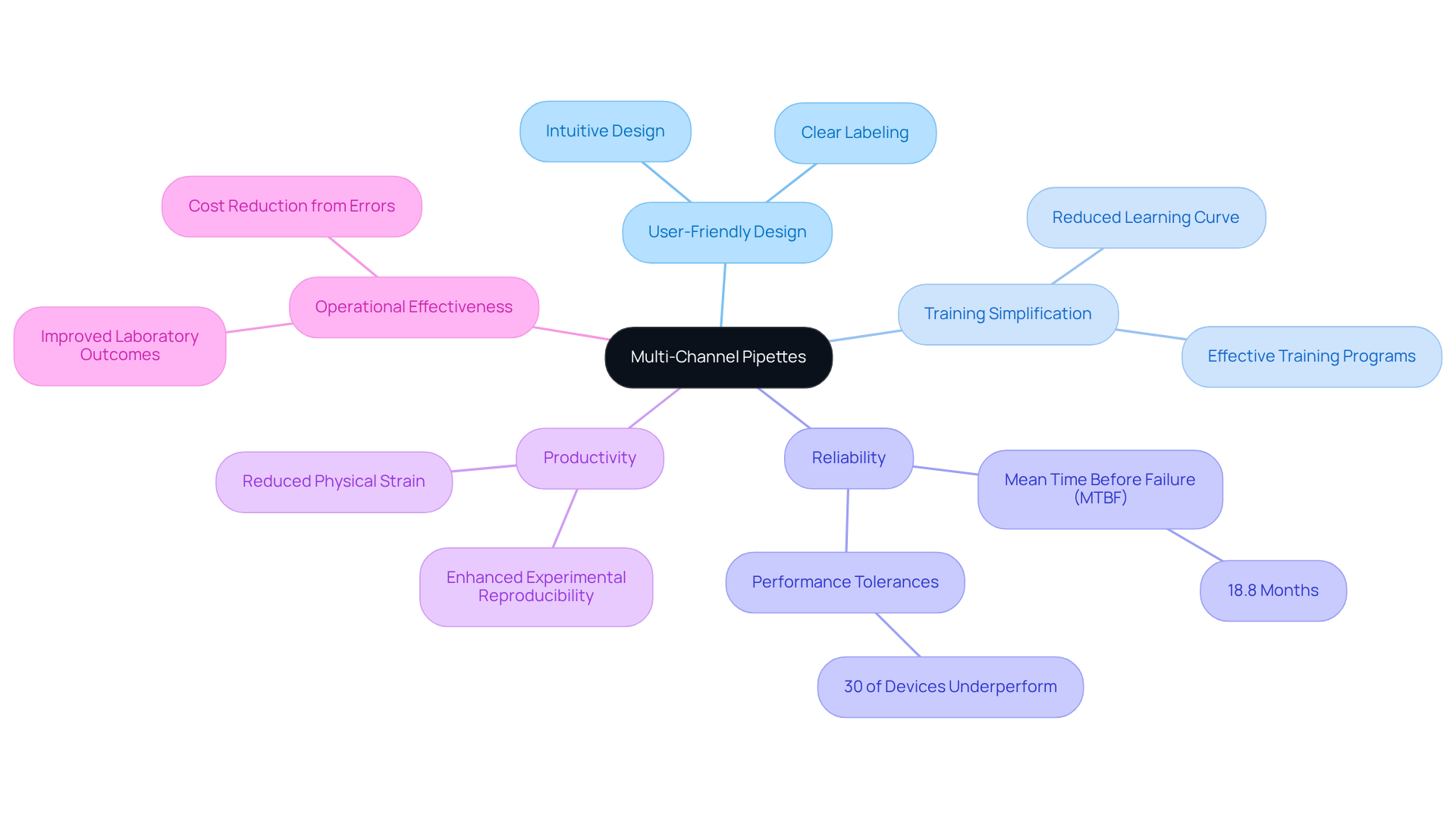
Compatibility: Integrating Multi-Channel Pipettes with Laboratory Equipment
Multi-channel pipettes are specifically designed to integrate seamlessly with a wide range of scientific apparatus, including microplates, reagent containers, and automated fluid handling systems. This compatibility enables smooth incorporation into existing workflows, allowing laboratories to enhance their liquid handling capabilities without the need for extensive modifications.
By ensuring that various-channel dispensers can function alongside other devices, JM Science fosters a more efficient working environment. Such integration not only streamlines processes but also elevates the overall productivity of laboratory operations.
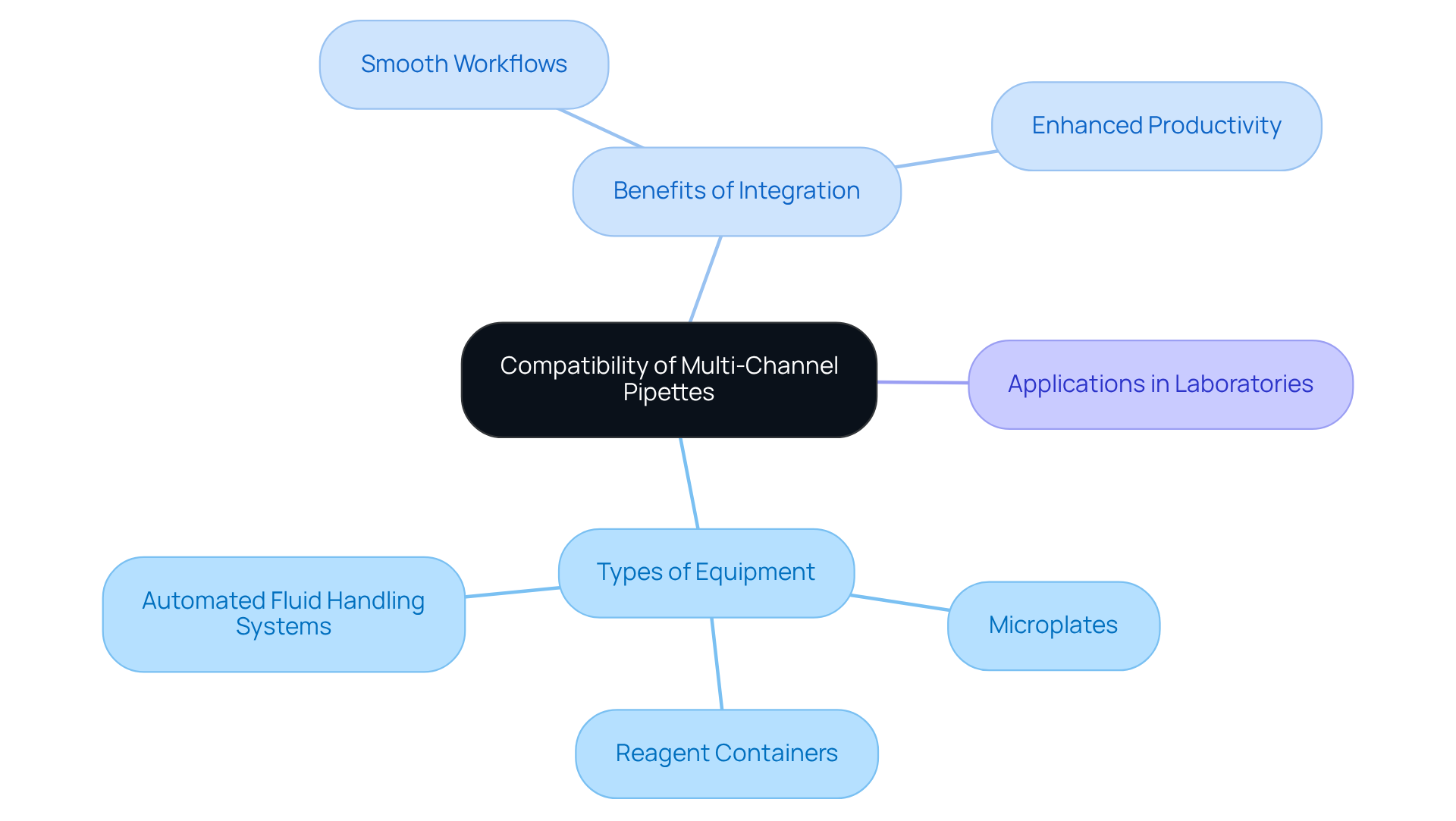
Durability and Maintenance: Ensuring Longevity of Multi-Channel Pipettes
Multi-channel dispensers from JM Science are engineered for durability, utilizing robust materials that meet the demands of daily scientific operations. To maximize their lifespan and ensure optimal performance, regular maintenance is essential. This maintenance routine encompasses:
- Thorough cleaning
- Calibration
- Adherence to best practices, including the use of appropriate personal protective equipment (PPE) during maintenance to guarantee safety.
Calibration should be conducted every 3 to 6 months or following any noticeable performance irregularities; even a slight deviation of a few microliters in quantitative analysis can result in significant variations in final outcomes. By implementing these maintenance techniques, facilities can substantially extend the lifespan of multi-channel pipettes, which can last several years with proper care. Notably, instances of durability in multi-channel pipettes are evident in laboratories that consistently follow maintenance protocols, resulting in sustained precision and reliability in their fluid transfer tasks.
As emphasized by lab supervisors, dedicating time to maintenance not only preserves the functionality of equipment but also enhances the overall quality of experimental outcomes. Dr. Gordon Sinclair underscores this point, stating, "Precision in liquid measurement is not merely an option; it’s a necessity in science," thereby reinforcing the critical nature of diligent maintenance practices.
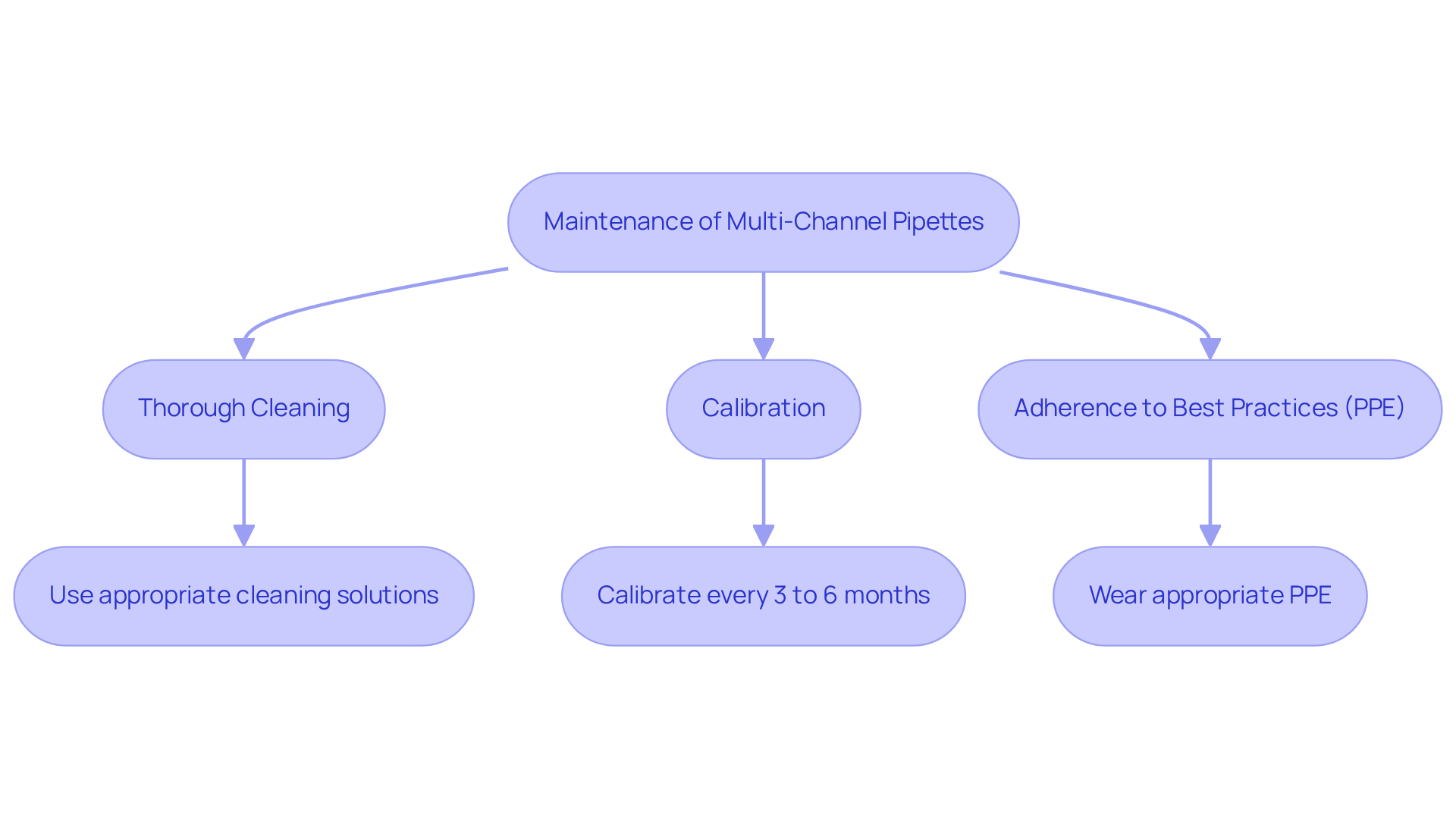
Regulatory Compliance: Supporting Standards with Multi-Channel Pipettes
Multi-channel devices are indispensable in ensuring regulatory compliance within pharmaceutical research facilities. These tools deliver precise and consistent outcomes, enabling laboratories to adhere to stringent industry standards and guidelines. JM Science is committed to manufacturing multi-channel pipettes that meet or exceed these regulatory requirements. This dedication instills confidence in laboratories regarding their liquid handling processes and the integrity of their research outcomes. By prioritizing quality and compliance, JM Science empowers researchers to focus on innovation and excellence in their work.
Conclusion
Multi-channel pipettes are indispensable instruments in pharmaceutical laboratories, significantly enhancing precision and efficiency in liquid handling tasks. By integrating advanced technology and ergonomic designs, these tools markedly reduce human error and streamline workflows, allowing researchers to concentrate on critical analyses instead of repetitive tasks. Their capability to manage multiple samples simultaneously not only elevates productivity but also fosters a more sustainable laboratory environment through decreased reagent consumption.
The article underscores several essential benefits of multi-channel pipettes, such as:
- Heightened efficiency in sample preparation
- Cost-effectiveness through minimized waste
- Versatility across various applications
- Improved accuracy in experimental results
The user-friendly design facilitates training for new staff, while compatibility with existing laboratory equipment guarantees seamless integration into current workflows. Furthermore, the focus on durability and regular maintenance highlights the significance of these instruments in achieving reliable outcomes, particularly in adherence to stringent regulatory standards.
Ultimately, the adoption of multi-channel pipettes signifies a substantial advancement in laboratory practices, promoting operational effectiveness and nurturing a healthier work environment. As pharmaceutical research continues to progress, investing in high-quality multi-channel pipettes will be crucial for laboratories striving to enhance their productivity and uphold the integrity of their research. Embracing these tools not only supports the objectives of innovation and excellence but also reinforces the commitment to precise and reliable scientific work.




